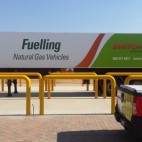In one of the success stories of 2016, Transnet National Ports Authority has allocated R7-billion to build new port facilities to grow South Africa’s ocean economy, with major developments in the oil and gas hubs of South Africa
Already, 200 jobs had been created in new port facilities. Over the last 12 months, existing ports had been refurbished and maintained, the Economic Sectors, Employment and Infrastructure Development cluster said yesterday.
“Through the public-private partnership to establish Saldanha Bay as an oil and gas hub, an investment of R9.2-billion has been realised, which will be utilised over the next five years,” Land Reform Minister Gugile Nkwinti explained.
“With 14 licences issued for oil and gas exploration, drilling of two exploration wells for potential oil and gas finds will take place along the South African coast. The investment in gas infrastructure has commenced and will contribute to energy security.”
Work on the offshore supply base has started, which will lead to Saldanha Bay attracting oil rigs for maintenance and repair. This will create secondary job opportunities for surrounding communities.
The expansion of aquaculture projects to inland and other coastal areas in support of SMMEs will create 3 200 jobs and contribute R500- million to the gross domestic product over the next year, according to reports.
The first two bulk carrier vessels have been registered in Port Elizabeth, and a third tanker in Cape Town, providing opportunities for South African cadets (trainees) boarding these vessels.
The boat-building sector had been revitalised, according to the cluster, leading to 500 direct jobs and 3 000 indirect jobs.
Nkwinti clarified that “an amount of R353-million over the next three years has already been unlocked in the ports of Durban and Cape Town for boat-building infrastructure through incentives provided by government.
“Further investments in boat building—catamaran production, workboat ferries for the navy, two offshore mining vessels and tugboats for the ports authority—and a fuel storage facility amount to approximately R3.6-billion,” concluded Nkwinti.
Programme to boost transformation in the oil industry reaches ten-year milestone
Entrepreneur investors in South Africa’s petroleum sector have successfully managed to overcome what can be high barriers to entry through a partnership with Chevron South Africa.
The programme was developed to help integrate new entrants into the value chain of the petroleum retail market. This partnership has reached a strategic ten-year milestone with 11 black empowered companies, who together account for 53 percent of Caltex’s retail volume (South Africa and Botswana), across 432 Branded Marketer supplied service stations in South Africa and another 32 in Botswana.
According to Pat Mdoda, Branded Marketer in Mpumalanga South, the partnership with Chevron South Africa through the Caltex brand has allowed them to introduce black entrepreneurs wherever possible in the supply of petroleum services. “This has enhanced transformation in the petroleum sector and removed barriers to entry for black entrepreneurs,” he said.
Kwa-Zulu Natal Branded Marketer Ahmed Patel managing director of AllFuels commented that “Chevron’s Branded Marketer concept has opened up the fuel retail industry to B-BBEE players, which was once the domain of oil majors.”
“It has removed the perception that B-BBEE entities are not geared to meet the specific challenges or lack the skill and knowledge to tackle this sector. This has allowed us to grow market share and create more employment within the region that we operate in,” he added.
“In the last ten years, Chevron South Africa has played a significant role in transforming the fuel industry in South Africa with the introduction of the Branded Marketer business model. The model has proved to be a huge success with an aggregate of 73% black ownership. In the Eastern Cape alone, the acquisition deal by the Branded Marketer makes it the largest Caltex fuel marketer in Chevron South Africa’s Africa region, totalling 101 outlets,” says Price Njokweni, General Manager Sales and Marketing Support - Chevron South Africa.
Njokweni added that the partnership has allowed Chevron South Africa to increase its retail presence in historically disadvantaged communities that were underrepresented to begin with. These outlets have served as the centre for economic activity in some rural communities and have contributed significantly to the creation of direct and indirect jobs.
Leveraging Chevron’s global experience, while adapting to local operating conditions, has provided a framework for the company to introduce equity into the hands of local businesses. These entities are fully authorised to conduct business under the Caltex brand including product supply and entering into contract with retailers in their designated territories.
Njokweni remarked that the partnership has been mutually beneficial and the Branded Marketers have grown their clusters by raising the levels of service and capability, while making investments in their own businesses.
“Over the past few years, we have been able to grow our business and create employment for many South Africans,” Mdoda remarked.
“These new entrants to the petroleum sector have transitioned from being just new entrants into formidable businesses fully supporting the country’s socio-economic transformation and contributing to Chevron South Africa’s growth,” said Njokweni.
East Africa to shine?
East Africa holds the ticket to Africa’s oil and gas hopes - especially the gas finds in Mozambique and Tanzania, according to Nivan Moodley, director of MAC Consulting.
While the drop in the oil price had impacted significantly on several oil-dependent economies in Africa and many of the high-growth economies were seeing slowdowns, Moodley said he remained bullish about East Africa and its prospects.
“In the oil business at the moment it is about survival. Operational improvements have to be made, more efficiencies brought in and costs reduced as far as possible. The rise of LNG would continue to impact on the region where developments might be slower than what was initially intended but were still ongoing.
“All is definitely not lost. There are still windows of opportunity. Africa retains the potential to grow and while the rates forecast are significantly down compared to initial expectations it is still growing. One must not forget that in comparison to most other regions in the world, Africa is still growing at the highest rates,” said Moodley










